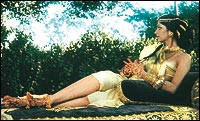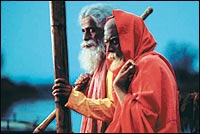
|
Siddhartha, a lost tale
Reviving the magic of the Shashi Kapoor-Simi Garewal classic
|
Aseem Chhabra
In 1972, Columbia Pictures released director Conrad Rooks's Siddhartha, a visually stunning film about a young Brahmin's quest for the meaning of life.
Based on Hermann Hesse's 1922 novel of the same name, Siddhartha starred Shashi Kapoor in the title role and Simi Garewal as Kamala, a courtesan who introduces him to the pleasures of sex and other material aspects of life.
Winner of the Silver Lion Award at the Venice film festival, Siddhartha was not well received by American critics, but the audience in the country, ripped apart by the war in Vietnam and the aftermath of the civil rights movement, took a liking to the film.
Siddhartha eventually became a cult classic. The film especially found an audience on college campuses where students and other knowledge seekers could relate to the over 2,000-year-old tale of a young Brahmin's angst and the film's message of individualism.
Siddhartha had a strong life in art house movie circles until 1987, after which it was withdrawn from distribution.
 Now, 30 years later and 80 years after Hesse wrote his book, Siddhartha has been restored by a German production company Winkler Films and is being slowly released in US art theatres by Milestone Films, a small New Jersey-based specialised distribution shop.
Now, 30 years later and 80 years after Hesse wrote his book, Siddhartha has been restored by a German production company Winkler Films and is being slowly released in US art theatres by Milestone Films, a small New Jersey-based specialised distribution shop.
The film has already had a successful run on the West Coast and is showing in New York City at the Anthology Film Archives in the East Village until September 29.
For a 1972 film, Siddhartha's primary audience continues to be people who studied Hesse's book in college, says Dennis Doros of Milestone Films. Hesse's book is still a required reading in several American colleges and its philosophy of looking for happiness in one's own self has also found support from an unexpected source: celebrity sports players.
Last year Phil Jackson, the LA Lakers coach gave a copy of the book to basketball legend Shaquille O'Neal. 'I wanted Shaq to sense the discipline, the asceticism, the denial of food, sleep and other deprivations of Siddhartha along the path to salvation, and to see how Siddhartha found salvation finally through good works,' Jackson said last year. 'I wanted Shaq to take the steps to inner peace, to become quiet, to get into the attitude of non-attention to desire. Not to eliminate it, but not to fall prey to desire.'
Siddhartha is also the favourite book of baseball star Shawn Green, the right fielder of the LA Dodgers (coincidentally, he was born the same year Rooks' film was released). When asked recently by a reporter whether he was seeking the answers to human existence, he said the following: 'I think a lot of people do, don't they?'
For those in India who remember, Siddhartha was rife with controversies from the get go. Rooks, who was reportedly encouraged by Raj Kapoor to become a filmmaker, had a difficult time convincing the Ministry of Information and Broadcasting to shoot the film. The Indian government had been disappointed by Louis Malle's 1969 documentary series, Phantom India, and it was reluctant to once again take a risk with a Western filmmaker.
Rooks eventually used the influence of his friend, the Maharaja of Bharatpur and even Indira Gandhi to be allowed to shoot the film. The film was actually shot at the height of India-Pakistan's war over Bangladesh's independence.
 Then there was the kissing and the nude scenes between Kapoor and Garewal and the erotic still shots inspired by the Khajuraho temple statues. The Indian film gossip magazines had a field day. No Bollywood stars of the time had posed nude or kissed on screen. (Even this writer, then a young teen, had a brush with the Siddhartha mania. The erotic photographs in the film were shot by one O P Sharma, who was my photography teacher at Modern School in New Delhi.)
Then there was the kissing and the nude scenes between Kapoor and Garewal and the erotic still shots inspired by the Khajuraho temple statues. The Indian film gossip magazines had a field day. No Bollywood stars of the time had posed nude or kissed on screen. (Even this writer, then a young teen, had a brush with the Siddhartha mania. The erotic photographs in the film were shot by one O P Sharma, who was my photography teacher at Modern School in New Delhi.)
Siddhartha tested the patience of the film censor board in India, but eventually the film was released, with limited cuts.
The restored Siddhartha lives up to all the excitement it generated when it was originally made. Although Shashi Kapoor's dialogue delivery is static and often very unconvincing, it is indeed a treat to watch the star at his prime, a far cry from his obese self as witnessed in his recent works Stephen Frears' Sammy And Rosie Get Laid (1987), Ismail Merchant's In Custody (1993) and the television mini-series Gulliver's Travels (1996).
As Kamala, the ravishing Garewal is at her sophisticated best, although her performance appears stilted.
Siddhartha needs to be viewed for its leisurely pace and its stunning photography. The film was shot by the master of light and shade Swedish cinematographer Sven Nykvist, who worked on practically all of Ingmar Berman's films. Most of the film was shot in Northern India in and around the holy city of Hrishikesh and in the private estate of the Maharaja of Bharatpur.
Then there is the magic of Hemant Kumar's voice. The Bengali singer composed the music for Siddhartha and in the process, lent two of his previously recorded songs for Rooks's film. The two songs are Pather klanti bhule and O nodire ekti kautha shudhai shudhu tomare. Kumar used the same composition for Lata Mangeshkar's hit Hindi song O bekarar dil for the 1964 film Kohra. No viewer can escape the haunting sounds of the two songs.
One is sure to walk out of the theater humming the tune of O nodire. The song is repeated with film's closing credits.
Finally Siddhartha needs to be seen as an ode to Conrad Rooks's fascinating and messy life, infused with drugs and alcohol, large parts of which were spent in India and in New York. Rooks grew up in the wealthy town of Chappaqua, in Westchester County, just north of New York City. (Former US President Bill and Hillary Clinton currently make their home in Chappaqua.) His father was a CEO of Avon corporation and Rooks used a part of his inheritance to produce his two films: Chappaqua, a surreal exploration of his involvement with drugs, and Siddhartha.
Rooks was introduced to Hesse's book by his first wife a Romonov Princess and the first cousin of the Tsar. After his first wife became a Buddhist nun, Rooks married an Indian filmmaker Pamela Rooks (Miss Beatty's Children in 1992 and Train To Pakistan in 1998). He lived in New Delhi for ten years with his second wife. He has since live in Pattaya, Thailand. He has never made an attempt to repeat the success of Siddhartha, a story that he identified with.